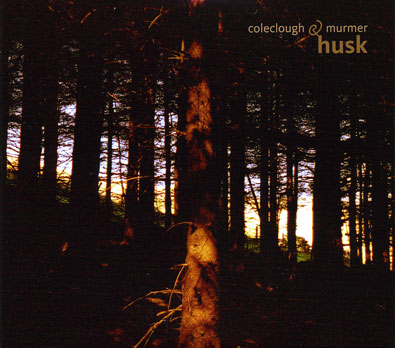[ezcol_1half]
::: husk (w/ jonathan coleclough) :::
::: icr ::: cd/2cd/2cd+cdr ::: 2006 :::
‘Husk’ is the first product of an ongoing collaboration between Jonathan Coleclough and murmer. They first met in 2002 after appearing on the compilation LP ‘Chaleur’, and soon began work on the material that would become ‘Husk.’ Sharing a fascination with ‘found sound’, ‘Husk’ includes recordings of refrigerators, thunderstorms, sheep, car horns, ferryboats, windblown sand, crackling charcoal, as well as more conventional instrumental sounds including a variety of percussion. Much of the music started as live improvisation, in one case during a radio broadcast on McGinley’s regular ‘Framework’ slot on the London-based Resonance FM. These live recordings have been carefully edited and mixed over several years.
‘Husk’ is packaged in a 6-panel Digisleeve featuring photographs by Patrick McGinley.
The first 200 copies of ‘Husk’ included a second CD of pieces recorded over the same period. A further 47 copies (only 25 of them for sale) included both CDs plus an additional uniquely packaged CDR, each one containing a unique composition. The music for these CDRs is based entirely on recordings made in McGinley’s London home during April 2006, his final month there before moving to France.
‘Husk’ is released in three versions:
Standard edition: ICR57 (edition of 700)
Special edition 1: ICR57 + ICR58 (edition of 200)
Special edition 2: ICR57 + ICR58 + ICR59 (edition of 47, only 25 for sale)
CD · ICR57
1. Husk (30.36)
2. Approaching Pucara (14.30)
3. Fieldwork (7.51)
4. Germ (21.19)
Bonus CD · ICR58
1. Wend (20.55)
2. Freon (15.16)
3. Pucara (8.49)
Bonus CDR · ICR59
1. Nevill (approx 5 minutes: each version unique)
[/ezcol_1half][ezcol_1half_end] [/ezcol_1half_end][ezcol_4fifth]
[/ezcol_1half_end][ezcol_4fifth]
::: reviews :::
In his previous collaborations with Colin Potter, Andrew Chalk, Tim Hill and most recently Lethe, Jonathan Coleclough has demonstrated his ability to distil sonorous frequencies, impressionistic tones and smeared ambiences from any given source material or field recording into supernal, droning compositions. Patrick McGinley, aka Murmer, also manipulates field recordings and environmental sounds, often emphasising the tactility intrinsic to each of his sources. Together, they make a formidable duo. While the exact source materials for the four tracks on Husk aren’t specified, enough information can be gleaned from the sounds to connect the dots if one wishes. The 20 minute title track is a sinewy composition, bouncing distant metallic clangs and windswept debris across the stereo field, multiplying resonant shimmers into a chorus of singing electrons. After an undulating series of phasing shifts (reminiscent of Coleclough’s Period solo outing), ‘Husk’ crescendos on a threatening torrent of protracted, shadowy sonics. Approaching Pucara’ situates a vaporous drone behind an occasional growl from what sounds like a motor agitating a wire. The strategy of layering a tactile event on top of a fluctuating tone is a commonplace within the realm of dronescaping, and this piece is not the duo’s best. ‘Fieldwork’ and ‘Germ’ are more successful. The latter derives exquisite interplay from a tangled network of hissing textures, and the former surges with the bleak Isolationist language of Thomas Köner. Barring a flaw here or there, Husk stands as one of the finest drone records of the year.
::: jim haynes ::: the wire #270, august 2006 :::
::: frans de waard ::: vital weekly #531, june 2006 :::
::: massimo ricci ::: paris transatlantic, september 2006 :::
[/ezcol_4fifth]